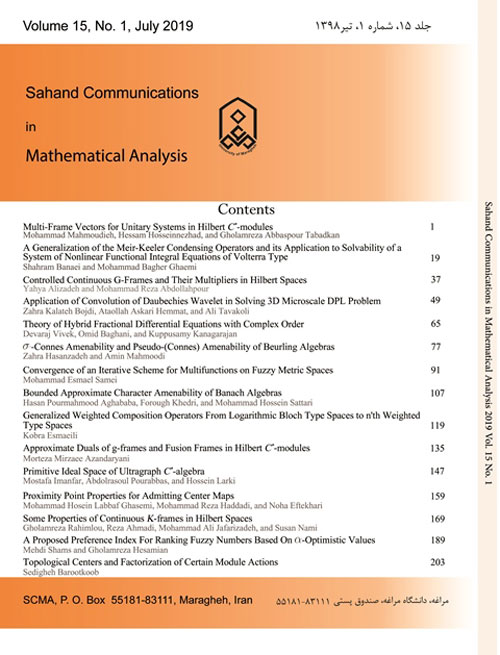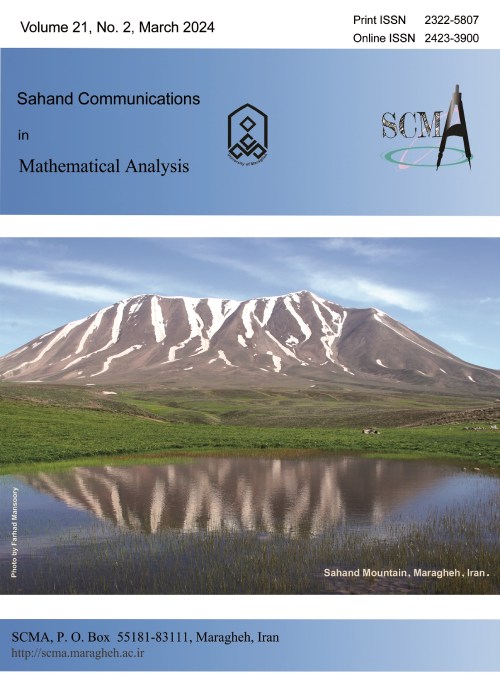فهرست مطالب

Sahand Communications in Mathematical Analysis
Volume:15 Issue: 1, Summer 2019
- تاریخ انتشار: 1398/04/10
- تعداد عناوین: 15
-
Pages 1-18In this paper, we focus on the structured multi-frame vectors in Hilbert C*-modules. More precisely, it will be shown that the set of all complete multi-frame vectors for a unitary system can be parameterized by the set of all surjective operators, in the local commutant. Similar results hold for the set of all complete wandering vectors and complete multi-Riesz vectors, when the surjective operator is replaced by unitary and invertible operators, respectively. Moreover, we show that new multi-frames (resp. multi-Riesz bases) can be obtained as linear combinations of known ones using coefficients which are operators in a certain class.Keywords: Multi-frame vector, Wandering vector, Local commutant, Unitary system
-
Pages 19-35In this paper, we generalize the Meir-Keeler condensing operators via a concept of the class of operators O (f;.), that was given by Altun and Turkoglu [4], and apply this extension to obtain some tripled fixed point theorems. As an application of this extension, we analyze the existence of solution for a system of nonlinear functional integral equations of Volterra type. Finally, we present an example to show the effectiveness of our results. We use the technique of measure of noncompactness to obtain our results.Keywords: Measure of noncompactness, Fixed point theorem, Integral equations
-
Pages 37-48In this paper, we introduce (mathcal{C},mathcal{C}')-controlled continuous g-Bessel families and their multipliers in Hilbert spaces and investigate some of their properties. We show that under some conditions sum of two (mathcal{C},mathcal{C}')-controlled continuous g-frames is a (mathcal{C},mathcal{C}')-controlled continuous g-frame. Also, we investigate when a (mathcal{C},mathcal{C}')-controlled continuous g-Bessel multiplier is a p-Schatten class operator.Keywords: Controlled continuous g-frames, (mathcal{C}, mathcal{C}')-controlled continuous g-Bessel families, Multiplier of continuous g-frames
-
Pages 49-63In this work, the triple convolution of Daubechies wavelet is used to solve the three dimensional (3D) microscale Dual Phase Lag (DPL) problem. Also, numerical solution of 3D time-dependent initial-boundary value problems of a microscopic heat equation is presented. To generate a 3D wavelet we used the triple convolution of a one dimensional wavelet. Using convolution we get a scaling function and a sevenfold 3D wavelet and all of our computations are based on this new set to approximate in 3D spatial. Moreover, approximation in time domain is based on finite difference method. By substitution in the 3D DPL model, the differential equation converts to a linear system of equations and related system is solved directly. We use the Lax-Richtmyer theorem to investigate the consistency, stability and convergence analysis of our method. Numerical results are presented and compared with the analytical solution to show the efficiency of the method.Keywords: MRA, Heat equation, wavelet method, Finite difference
-
Pages 65-76We develop the theory of hybrid fractional differential equations with the complex order thetain mathbb{C}, theta=m+ialpha, 0<mleq 1, alphain mathbb{R}, in Caputo sense. Using Dhage's type fixed point theorem for the product of abstract nonlinear operators in Banach algebra; one of the operators is mathfrak{D}- Lipschitzian and the other one is completely continuous, we prove the existence of mild solutions of initial value problems for hybrid fractional differential equations. Finally, an application to solve one-variable linear fractional Schr"odinger equation with complex order is given.Keywords: Hybrid fractional differential equations, Initial value problem, Complex order, Dhage's fixed point theorems, Existence of mild solution
-
Pages 77-89In this paper, pseudo-amenability and pseudo-Connes amenability of weighted semigroup algebra ell^1(S,omega) are studied. It is proved that pseudo-Connes amenability and pseudo-amenability of weighted group algebra ell^1(G,omega) are the same. Examples are given to show that the class of sigma-Connes amenable dual Banach algebras is larger than that of Connes amenable dual Banach algebras.Keywords: sigma-Connes amenability, Pseudo-amenability, Pseudo-Connes amenability, Beurling algebras
-
Pages 91-106Recently, Reich and Zaslavski have studied a new inexact iterative scheme for fixed points of contractive and nonexpansive multifunctions. In 2011, Aleomraninejad, et. al. generalized some of their results to Suzuki-type multifunctions. The study of iterative schemes for various classes of contractive and nonexpansive mappings is a central topic in fixed point theory. The importance of Banach contraction principle is that it also gives the convergence of an iterative scheme to a unique fixed point. In this paper, we consider (X, M, *) to be fuzzy metric spaces in Park's sense and we show our results for fixed points of contractive and nonexpansive multifunctions on Hausdorff fuzzy metric space.Keywords: Inexact iterative, Fixed point, Contraction multifunction, Hausdorff fuzzy metric
-
Pages 107-118The bounded approximate version of $varphi$-amenability and character amenability are introduced and studied. These new notions are characterized in several different ways, and some hereditary properties of them are established. The general theory for these concepts is also developed. Moreover, some examples are given to show that these notions are different from the others. Finally, bounded approximate character amenability of some Banach algebras related to locally compact groups are investigated.Keywords: Banach algebras, Bounded approximate character amenability, Bounded approximate character contractibility, Locally compact groups
-
Pages 119-133Let H(D) denote the space of analytic functions on the open unit disc D. For a weight and a nonnegative integer n, the n'th weighted type space W(n) is the space of all f 2 H(D) such that supz2D (z) f(n)(z) < 1: Endowed with the norm ∥f∥ W(n) = nΣ 1 j=0 f(j)(0) + sup z2D (z) f(n)(z) ; the n'th weighted type space is a Banach space. In this paper, we characterize the boundedness of generalized weighted composition operators Dm φ;u from logarithmic Bloch type spaces B log to n'th weighted type spaces W(n) , where u and φ are analytic functions on D and φ(D) D. We also provide an estimation for the essential norm of these operators.Keywords: Essential norms, Generalized weighted composition operators, Logarithmic Bloch type spaces, N th weighted type spaces
-
Pages 135-146In this paper, we study approximate duals of g-frames and fusion frames in Hilbert Cast-modules. We get some relations between approximate duals of g-frames and biorthogonal Bessel sequences, and using these relations, some results for approximate duals of modular Riesz bases and fusion frames are obtained. Moreover, we generalize the concept of Q-approximate duality of g-frames and fusion frames to Hilbert C^ast-modules, where Q is an adjointable operator, and obtain some properties of this kind of approximate duals.Keywords: Frame, g-frame, Fusion frame, Biorthogonal sequence, Approximate duality
-
Pages 147-158In this paper, we describe the primitive ideal space of the C*-algebra C*(mathcal G) associated to the ultragraph mathcal{G}. We investigate the structure of the closed ideals of the quotient ultragraph C* -algebra C*left(mathcal G/(H,S)right) which contain no nonzero set projections and then we characterize all non gauge-invariant primitive ideals. Our results generalize the Hong and Szyma acute{ mathrm { n } } ski's description of the primitive ideal space of a graph C * -algebra by a simpler method.Keywords: Ultragraph, Ultragraph C*-algebra, Primitive ideal
-
Pages 159-167In this work we investigate a class of admitting center maps on a metric space. We state and prove some fixed point and best proximity point theorems for them. We obtain some results and relevant examples. In particular, we show that if X is a reflexive Banach space with the Opial condition and T:Crightarrow X is a continuous admiting center map, then T has a fixed point in X. Also, we show that in some conditions, the set of all best proximity points is nonempty and compact.Keywords: Admitting center map, Nonexpansive map, Cochebyshev set, Best proximity pair
-
Pages 169-187The theory of continuous frames in Hilbert spaces is extended, by using the concepts of measure spaces, in order to get the results of a new application of operator theory. The K-frames were introduced by Gbreve{mbox{a}}vruta (2012) for Hilbert spaces to study atomic systems with respect to a bounded linear operator. Due to the structure of K-frames, there are many differences between K-frames and standard frames. K-frames, which are a generalization of frames, allow us in a stable way, to reconstruct elements from the range of a bounded linear operator in a Hilbert space. In this paper, we get some new results on the continuous K-frames or briefly cK-frames, namely some operators preserving and some identities for cK-frames. Also, the stability of these frames are discussed.Keywords: K-frame, c-frame, cK-frame, Local cK-atoms
-
Pages 189-201In this paper, we propose a novel method for ranking a set of fuzzy numbers. In this method a preference index is proposed based on alpha-optimistic values of a fuzzy number. We propose a new ranking method by adopting a level of credit in the ordering procedure. Then, we investigate some desirable properties of the proposed ranking method.Keywords: alpha-Optimistic value, Fuzzy ranking, Preference index, Roboustness
-
Pages 203-215Let A be a Banach algebra and X be a Banach A-bimodule with the left and right module actions pi_ell: Atimes Xrightarrow X and pi_r: Xtimes Arightarrow X, respectively. In this paper, we study the topological centers of the left module action pi_{ell_n}: Atimes X{(n)}rightarrow X{(n)} and the right module action pi_{r_n}:X{(n)}times Arightarrow X{(n)}, which inherit from the module actions pi_ell and pi_r, and also the topological centers of their adjoints, from the factorization property point of view, and then, we investigate conditions under which these bilinear maps are Arens regular or strongly Arens irregular.Keywords: Topological centers, Module actions, Arens regular, Strongly Arens irregular


